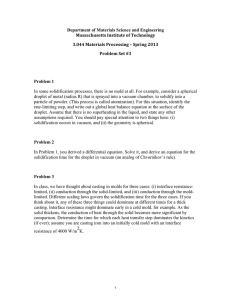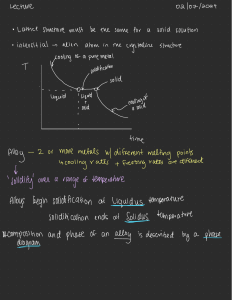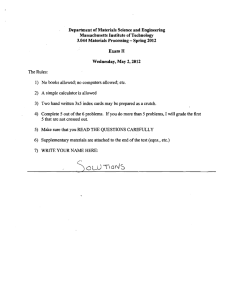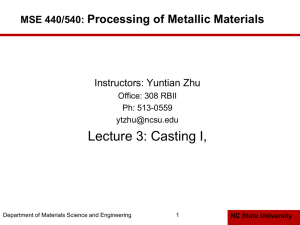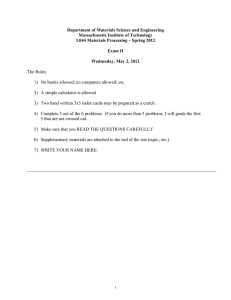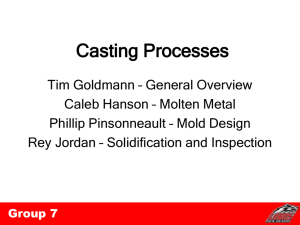Metal Casting Fundamentals: Processes, Solidification, and Design
advertisement
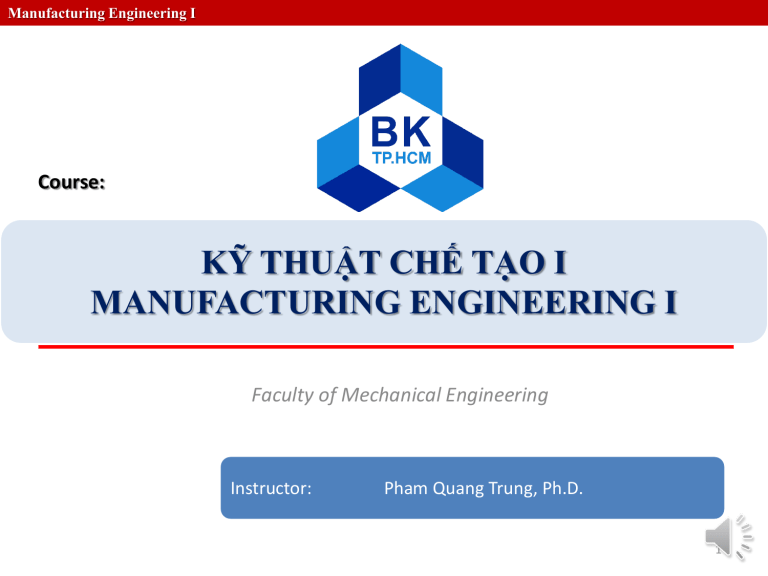
Manufacturing Engineering I Course: KỸ THUẬT CHẾ TẠO I MANUFACTURING ENGINEERING I Faculty of Mechanical Engineering Instructor: Pham Quang Trung, Ph.D. 1 Fundamentals of Metal Casting 1 Overview of Casting Technology 1.1 Casting Processes 1.2 Sand-Casting Molds 2 Heating and Pouring 2.1 Heating the Metal 2.2 Pouring the Molten Metal 2.3 Engineering Analysis of Pouring 2.4 Fluidity 3 Solidification and Cooling 3.1 Solidification of Metals 3.2 Solidification Time 3.3 Shrinkage 3.4 Directional Solidification 3.5 Riser Design 2 3. Solidification and Cooling After pouring into the mold, the molten metal cools and solidifies. This section examines the physical mechanism of solidification that occurs during casting. Issues associated with solidification include the time for a metal to freeze, shrinkage, directional solidification, and riser design. 3.1 SOLIDIFICATION OF METALS Solidification involves the transformation of the molten metal back into the solid state. The solidification process differs depending on whether the metal is a pure element or an alloy. 3 3.1 SOLIDIFICATION OF METALS Pure Metals A pure metal solidifies at a constant temperature equal to its freezing point, which is the same as its melting point. The process occurs over time as shown in the plot of Figure 10.4, called a cooling curve. The actual freezing takes time, called the local solidification time in casting, during which the metal’s latent heat of fusion is released into the surrounding mold. The total solidification time is the time taken between pouring and complete solidification. After the casting has completely solidified, cooling continues at a rate indicated by the downward slope of the cooling curve. 4 3.1 SOLIDIFICATION OF METALS Pure Metals: Microstructure Because of the chilling action of the mold wall, a thin skin of solid metal is initially formed at the interface immediately after pouring. This cooling action causes the grains in the skin to be fi ne and randomly oriented. Thickness of the skin increases to form a shell around the molten metal as solidification progresses inward toward the center of the cavity. The rate at which freezing proceeds depends on heat transfer into the mold, as well as the thermal properties of the metal. Figure: Characteristic grain structure in a casting of a pure metal, showing randomly oriented grains of small size near the mold wall, and large columnar grains oriented toward the center of the casting. As cooling continues, further grain formation and growth occur in a direction away from the heat transfer. Since the heat transfer is through the skin and mold wall, the grains grow inwardly as needles or spines of solid metal. As these spines enlarge, lateral branches form, and as these branches grow, further branches form at right angles to the first branches. This type of grain growth is referred to as dendritic growth, and it occurs not only in the freezing of pure metals but alloys as well. These treelike structures are gradually filled-in during freezing, as additional metal is continually deposited onto the dendrites until complete solidification has occurred. The grains resulting from this dendritic growth take on a preferred orientation, tending to be coarse, columnar grains aligned toward the center of the casting. 5 3.1 SOLIDIFICATION OF METALS Most Alloys Most alloys freeze over a temperature range rather than at a single temperature. The exact range depends on the alloy system and the particular composition. Solidification of an alloy can be explained with reference to Figure 10.6, which shows the phase diagram for a particular alloy system (Section 6.1.2) and the cooling curve for a given composition. As temperature drops, freezing begins at the temperature indicated by the liquidus and is completed when the solidus is reached. 6 Most Alloys 3.1 SOLIDIFICATION OF METALS Giảng đồ trạng thái pha của hợp kim Đồng và Nickel, giảng đồ trạng thái 2 cấu tử hòa tan vô hạn. 1. Nếu hợp kim có thành phần 100% Ni và 0% Cu, thì hợp kim sẽ hóa rắn ở nhiệt độ 1455 độ C, và nếu hợp kim có 0% Ni và 100% Cu thì sẽ hóa rắn ở nhiệt độ 1083 độ C. Khi đó hợp kim là kim loại nguyên chất (xem lại sơ đồ hóa của hợp kim nguyên chất). 2. Nếu hợp kim có tỉ lệ x% Ni và y%Cu, thì ta vẽ 1 đường thẳng từ trên xọc xuống, bắt đầu từ điểm A: khi đó hợp kim 100 là lỏng, tại điểm B hợp kim bắt đầu hóa rắn, điểm C hỗn hợp có 2 pha lỏng và rắn, điểm D hóa rắn hoàn toàn và điểm E là hợp kim đã nguội. 3.1 SOLIDIFICATION OF METALS Most Alloys Cooling curve Đường nguội của hợp kim Ni-Cu Quá trình đông đặc của hợp kim (Ni 50%-Cu 50%) diễn ra và kết thúc trong một khoảng nhiệt độ Most Alloys 3.1 SOLIDIFICATION OF METALS Example: Vẽ đường nguội của hợp kim có 2 cấu tử 25% Đồng và (75%) Nickel (hòa tan vô hạn) 3.1 SOLIDIFICATION OF METALS Most Alloys: Microstructure A thin skin is formed at the mold wall due to the large temperature gradient at this surface. Freezing then progresses as before through the formation of dendrites that grow away from the walls. However, owing to the temperature spread between the liquidus and solidus, the nature of the dendritic growth is such that an advancing zone is formed in which both liquid and solid metal coexist. This solid–liquid region has a soft consistency that has motivated its name as the mushy zone. Figure: Characteristic grain structure in an alloy casting, showing segregation of alloying components in the center of casting. 10 3.1 SOLIDIFICATION OF METALS Most Alloys: Microstructure Ngay khi rót kim loại lỏng vào khuôn, do tiếp xúc với thành khuôn nguội, lớp kim loại lỏng tiếp xúc thành khuôn có tốc độ nguội rất lớn sẽ kết tinh ngay thành một lớp kim loại mỏng. Bản thân thành khuôn đóng vai trò mầm ký sinh cũng làm tăng tốc độ tạo mầm và kết tinh. Chiều dày của lớp kim loại này tăng dần theo quá trình đông đặc, tạo thành một lớp vỏ kim loại bao xung quanh kim loại lỏng phía trong. Lớp kim loại này có cấu trúc hạt nhỏ, mịn, trục định hướng bất kỳ và rất mỏng (Vùng I) Vùng tiếp theo có cấu trúc tinh thể hạt dài, có phương vuông góc với thành khuôn. Tốc độ nguội càng lớn càng dễ dàng cho sự phát triển của tinh thể định hướng và chúng có thể tiếp xúc nhau ở trung tâm tạo thành tổ chức xuyên tinh. Tổ chức này có mật độ cao, nhưng dị hướng, dễ nứt khi bị biến dạng. (Vùng II) Vùng trong cùng có tổ chức những hạt đa cạnh. Lúc này, thành khuôn đã nóng lên, kết tinh xảy ra với độ quá nguội nhỏ, hướng tỏa nhiệt theo mọi phương gần như nhau, tinh thể phát triển đều theo mọi phương tạo ra tổ chức hạt thô đều trục. (Vùng III) Nguội nhanh: vùng II phát triển; Nguội chậm: vùng III phát triển 3.2 SOLIDIFICATION TIME Whether the casting is pure metal or alloy, solidification takes time. The total solidification time is the time required for the casting to solidify after pouring. This time is dependent on the size and shape of the casting by an empirical relationship known as Chvorinov’s rule, which states: where + TTS = total solidification time, min; + V = volume of the casting, cm3 (in3); + A = surface area of the casting, cm2 (in2); + n is an exponent usually taken to have a value = 2; and + Cm is the mold constant, min/cm2 (min/in2). WHAT IS THE MEANING OF THE Chvorinov’s rule ? 12 3.2 SOLIDIFICATION TIME WHAT IS THE MEANING OF THE Chvorinov’s rule ? + Chvorinov’s rule indicates that a casting with a higher volume-to-surface area ratio will cool and solidify more slowly than one with a lower ratio. + This principle is put to good use in designing the riser in a mold. To perform its function of feeding molten metal to the main cavity, the metal in the riser must remain in the liquid phase longer than the casting. + In other words, the TTS for the riser must exceed the TTS for the main casting. Since the mold conditions for both riser and casting are the same, their mold constants will be equal. + By designing the riser to have a larger volume-to-area ratio, the main casting will most likely solidify first and the effects of shrinkage will be minimized. + Before discussing how the riser might be designed based on Chvorinov’s rule, consider the topic of shrinkage, which is the reason why risers are needed. 13 3.2 SOLIDIFICATION TIME Problem 1 When casting low carbon steel under certain mold conditions, the mold constant in Chvorinov’s rule 4.0 min/cm2. Determine how long solidification will take for a rectangular casting whose length 30 cm, width 15 cm, and thickness 20 mm. Problem 2 A disk-shaped part is cast out of aluminum. Diameter of the disk 650 mm and thickness 16 mm. If the mold constant 2.2 sec/mm2 in Chvorinov’s rule, how long will it take the casting to solidify? 14 3.3 SHRINKAGE Shrinkage occurs in three steps: (1) liquid contraction during cooling prior to solidification; (2) contraction during the phase change from liquid to solid, called solidification shrinkage; (3) thermal contraction of the solidified casting during cooling to room temperature. The three steps can be explained with reference to a cylindrical casting made in an open mold. Shrinkage of a cylindrical casting during solidification and cooling: (0) starting level of molten metal immediately after pouring; (1) reduction in level caused by liquid contraction during cooling; (2) reduction in height and formation of shrinkage cavity caused by solidification shrinkage; and (3) further reduction in height and diameter due to thermal contraction during cooling of the solid metal. For clarity, dimensional reductions are exaggerated in our sketches. 15 3.3 SHRINKAGE Discussion: How to compensate for the solidification shrinkage problem in casting? 16 3.3 SHRINKAGE Discussion: How to compensate for the solidification shrinkage problem in casting? Compensation for solidification shrinkage is achieved in several ways depending on the casting operation. In sand casting, liquid metal is supplied to the cavity by means of risers (Section 10.3.5). In die casting (Section 11.3.3), the molten metal is applied under pressure. 17 3.3 DIRECTIONAL SOLIDIFICATION Question 1: In the casting sample, which parts should freeze first? Question 2: What is directional solidification? And how to control it? 18 3.3 DIRECTIONAL SOLIDIFICATION Question 1: In the casting sample, which parts should freeze first? Question 2: What is directional solidification? + In order to minimize the damaging effects of shrinkage, it is desirable for the regions of the casting most distant from the liquid metal supply to freeze first and for solidification to progress from these remote regions toward the riser(s). + In this way, molten metal will continually be available from the risers to prevent shrinkage voids during freezing. The term directional solidification is used to describe this aspect of the freezing process and the methods by which it is controlled. 19 3.3 DIRECTIONAL SOLIDIFICATION Question 3: How can control the directional solidification? 20 3.3 DIRECTIONAL SOLIDIFICATION Question 3: How can control the directional solidification? + The desired directional solidification is achieved by observing Chvorinov’s rule in the design of the casting itself, its orientation within the mold, and the design of the riser system that feeds it. For example, by locating sections of the casting with lower V/A ratios away from the riser, freezing will occur first in these regions and the supply of liquid metal for the rest of the casting will remain open until these bulkier sections solidify. + Another way to encourage directional solidification is to use chills—internal or external heat sinks that cause rapid freezing in certain regions of the casting. + The passageway between the riser and the main cavity does not freeze before the casting and are short in length. 21 3.3 DIRECTIONAL SOLIDIFICATION Internal chills are small metal parts placed inside the cavity before pouring so that the molten metal will solidify first around these parts. The internal chill should have a chemical composition similar to the metal being poured, most readily achieved by making the chill out of the same metal as the casting itself. External chills are metal inserts in the walls of the mold cavity that can remove heat from the molten metal more rapidly than the surrounding sand in order to promote solidification. They are often used effectively in sections of the casting that are difficult to feed with liquid metal, thus encouraging rapid freezing in these sections while the connection to liquid metal is still open. Figure 10.9 illustrates a possible application of external chills and the likely result in the casting if the chill were not used. Figure: (a) External chill to encourage rapid freezing of the molten metal in a thin section of the casting; and (b) the likely result if the external chill were not used. 22 Review Questions 23 Thank you for your attention 24
